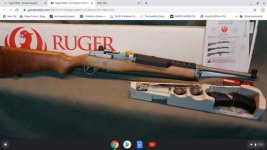rockquarry
Member
- Joined
- Aug 9, 2005
- Messages
- 8,624
- Reaction score
- 10,594
I posted a comparison of the Mini 14 180 series with the 181 and later series a year or so ago, and discussed the difference in accuracy on the box stock rifles. The 181 and later rifles gained a lot of reciprocating mass in the slide and that along with being badly over gassed (.080” gas bushing rather than .045”) really aggravated the barrel harmonics and killed the accuracy.
I’ve also posted about the changes made to my 184 and 187 series to improve accuracy (SOCOM length AccuStrut, Browning style Choate flash hider and front sight, .045” gas port bushing, Tech Sights rear sight, and a shock buffer) from 4-5 MOA to 1.5” 5 shot groups at 100 yards.
I’ve also covered the changes Ruger made in barrel twist starting with the original 1-10” twist, switching to the way over hyped and over rated 1-7 twist and finally switching back to the 1-9 twist.
The 1-7 twist barrels didn’t help accuracy at all. The 1-9 twist was actually idea, for the military M855 ball round and the 1-7 twist was only adopted for the M-16A2 and later M16 and M4 variants as it was needed to stabilize the much longer M856 tracer round. Do you shoot much M856 in your AR-15 or Mini 14? Neither do I or 99.9% of the other civilian shooters out there. However civilian shooters are more likely to shoot fairly low quality 55 and 62 gr FMJ bullets.
That’s a problem as most of the bulk FMJ bullets in that low cost category are not precisely made and as such the center of form and the center of gravity are not on the same axis. That means the bullet rotates around the center of form in the bore and then transitions to rotating around the center of gravity after it exits. That causes the bullet to wobble and the resulting yaw creates precession, and the faster the bullet is spinning the worse that precession will be. That causes the bullet to travel in a spiral pattern before settling down in some random and slightly different direction. Consequently accuracy with those bullets is worse in a 1-7 twist barrel than it is in a 1-12, 1-10 or 1-9 twist barrel. More twist isn’t better unless you are shooting very long match bullets.
One of the accuracy problems when with the Mini 14 is that it’s often unclear what barrel twist is used and shooters with the 1-7” barrels often shoot low cost low quality 55 gr FMJ in them with worse than average results.
This site is useful in terms in more or less what twist a given Mini 14 or Ranch rifle may have. It’s not exact as Ruger didn’t do clean transitions at a specific serial number, and Ruger had a very good policy of completely rebuilding law enforcement Mini 14s returned to the factory, and they used the barrels that were being put on new mini 14s at the time. But it’s a good general reference.
Sunflower Ammo.com: Ruger Mini-14/30 Barrel Twist Rates
As noted above in a prior post, the 580 and later series came off new tooling and not long after the retooling, Ruger started using a heavier tapered barrel. The two changes together improved accuracy and Ruger now expects 2 MOA accuracy on its new Mini 14s.
Good and useful response. 2 MOA is fine for anything I'd use a Mini-14 for. I wouldn't use a scope except for load development and never shoot past 200 yards.
As for cheap ammo... when I became interested in ARs several years ago, I bought three Colts and put scopes on two. The two with scopes were capable of 1" and smaller five-shot 100 yard groups straight out-of-the-box, unmolested and not modified, but only with expensive Federal or Winchester match ammo or handloads using Sierra bullets which actually did a little better than the factory match stuff.
For comparison, I bought eight or ten cheap commercial ammos. Functioning and reliability were fine, but accuracy was not. Complete waste of money, but apparently many are satisfied with this second-rate stuff. However, it's always best to try a few accurate ammos, commercial or handloads before pronouncing a gun as inaccurate.




